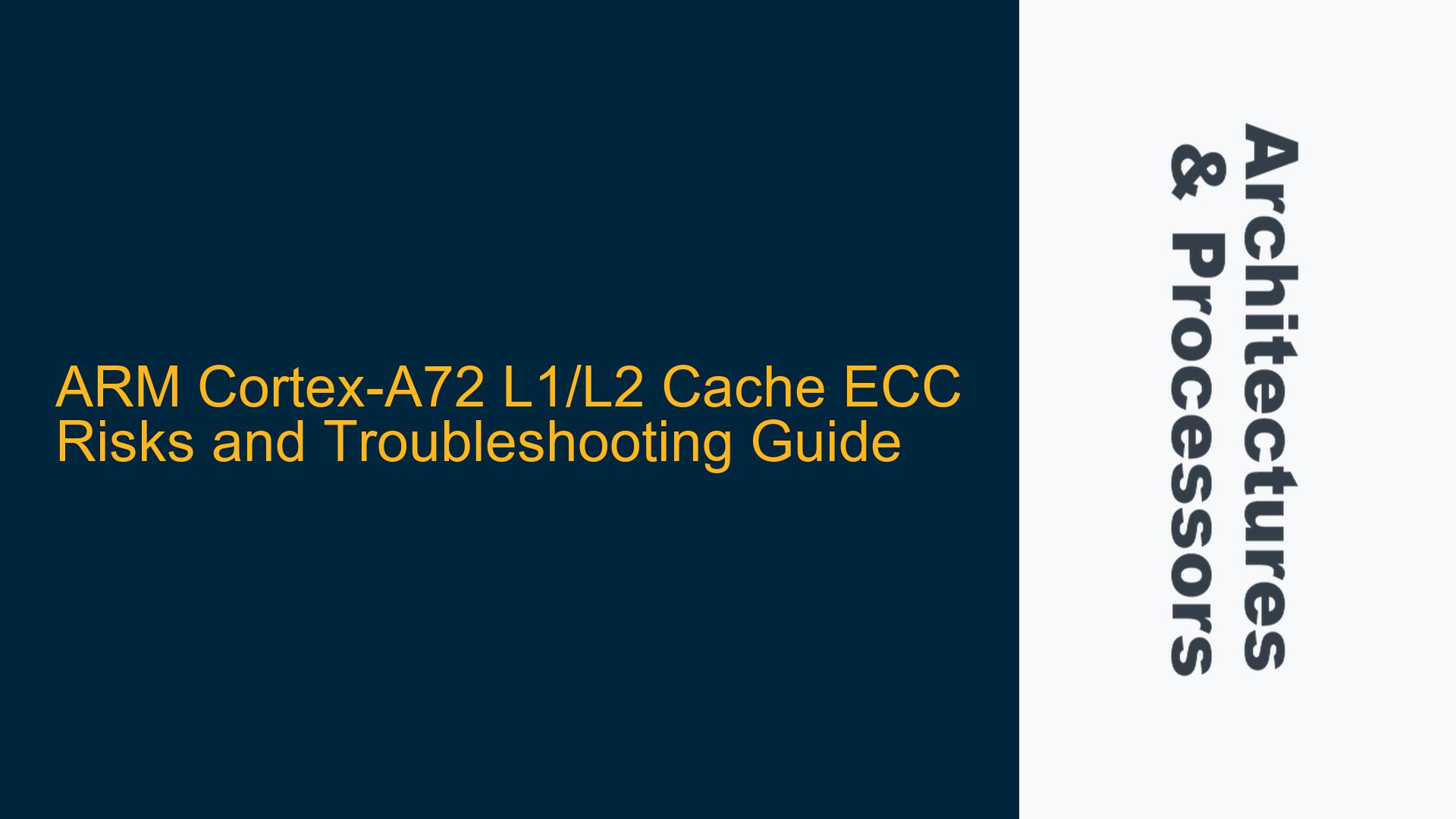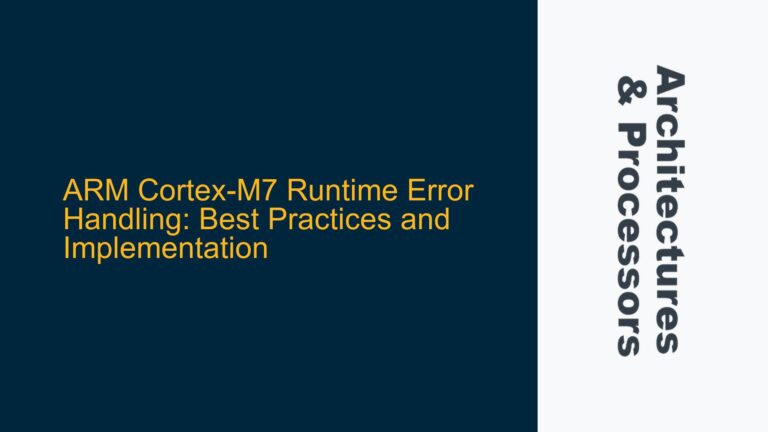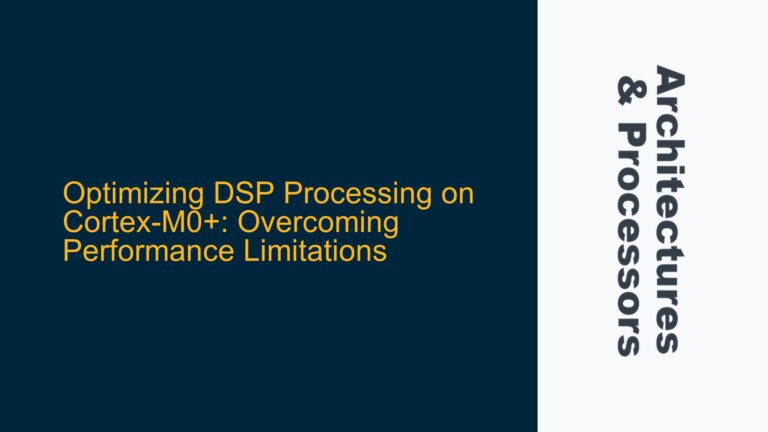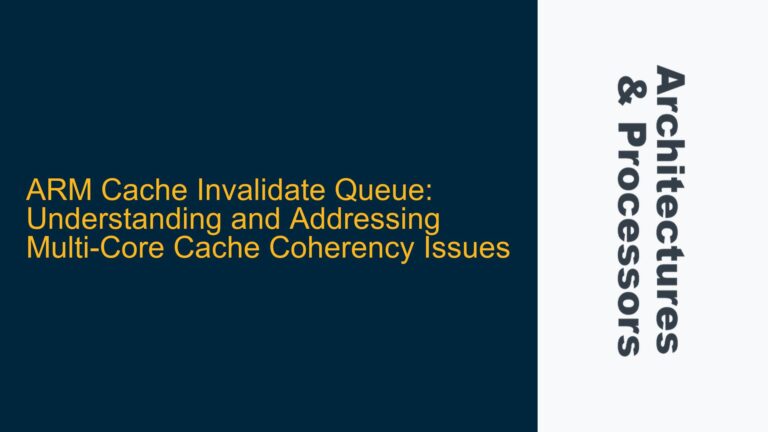ARM Cortex-A72 L1/L2 Cache ECC Disabling and Illegal Instruction Faults
The ARM Cortex-A72 processor is a high-performance CPU core designed for applications requiring robust computational capabilities. One of its critical features is the inclusion of Error Correction Code (ECC) mechanisms for both Level 1 (L1) and Level 2 (L2) caches. ECC is a memory error detection and correction technique that ensures data integrity by detecting and correcting single-bit errors and detecting multi-bit errors. However, in some implementations, the L1/L2 cache ECC might be disabled, leading to potential issues such as illegal instruction faults. These faults occur when the CPU attempts to execute an instruction that is not recognized or is corrupted, often due to bit flips in the cache memory.
In the case of the Cortex-A72, the L2CTLR_EL1 register controls various aspects of the L2 cache, including the enabling or disabling of ECC. Specifically, bit 21 of the L2CTLR_EL1 register is responsible for enabling or disabling ECC for both L1 and L2 caches. When this bit is set to 0, ECC is disabled, and the system becomes more vulnerable to bit flips, which can lead to illegal instruction faults. The value 0x01C00082 in the L2CTLR_EL1 register indicates that bit 21 is not set, meaning ECC is not enabled for the L1/L2 caches.
The absence of ECC in the L1/L2 caches can be particularly problematic in environments where the system is exposed to high levels of electromagnetic interference (EMI), radiation, or other conditions that can cause bit flips. Without ECC, even a single-bit error in the cache can lead to incorrect instruction execution, data corruption, or system crashes. This is especially critical in safety-critical applications such as automotive, aerospace, or medical devices, where data integrity is paramount.
Potential Risks of Enabling L1/L2 Cache ECC on Cortex-A72
Enabling ECC on the L1/L2 caches of the Cortex-A72 can mitigate the risks associated with bit flips and illegal instruction faults. However, there are several considerations and potential risks associated with enabling ECC that must be carefully evaluated.
First, enabling ECC introduces additional latency in cache access. ECC requires extra bits to store the error correction codes, and the process of encoding and decoding these bits adds overhead to cache read and write operations. This latency can impact the overall performance of the system, particularly in applications that are highly sensitive to timing, such as real-time systems or high-frequency trading platforms.
Second, enabling ECC increases the power consumption of the processor. The additional circuitry required for ECC encoding and decoding consumes more power, which can be a concern in battery-operated devices or systems with strict power budgets. The increased power consumption can also lead to higher thermal output, necessitating more robust cooling solutions.
Third, there is a risk of false positives or negatives in error detection and correction. While ECC is highly reliable, it is not infallible. In rare cases, ECC might fail to detect or correct an error, or it might incorrectly flag a correct data bit as erroneous. These scenarios can lead to unpredictable system behavior, including data corruption or system crashes.
Fourth, enabling ECC might require changes to the system software, particularly the operating system and device drivers. The software must be aware of the ECC capabilities and be able to handle ECC-related errors appropriately. This might involve modifying the error handling routines, cache management algorithms, and memory allocation strategies.
Finally, there is a risk of compatibility issues with existing hardware and software. Enabling ECC might expose previously undetected issues in the hardware design or software implementation. For example, certain hardware components might not be fully compatible with ECC-enabled caches, or the software might not be optimized to handle the additional latency introduced by ECC.
Enabling and Managing L1/L2 Cache ECC on Cortex-A72
To enable and manage L1/L2 cache ECC on the ARM Cortex-A72, a systematic approach is required to ensure that the benefits of ECC are realized without introducing new issues. The following steps outline the process of enabling ECC, verifying its functionality, and managing the associated risks.
Step 1: Verify Hardware Support for ECC
Before enabling ECC, it is essential to verify that the hardware supports ECC for the L1/L2 caches. This involves checking the processor datasheet and the system design documentation to confirm that the necessary circuitry and memory modules are in place to support ECC. Additionally, the system should be tested to ensure that it can handle the additional latency and power consumption associated with ECC.
Step 2: Enable ECC in the L2CTLR_EL1 Register
To enable ECC for the L1/L2 caches, bit 21 of the L2CTLR_EL1 register must be set to 1. This can be done by writing the appropriate value to the register using a privileged instruction. The following code snippet demonstrates how to enable ECC in the L2CTLR_EL1 register:
MRS X0, L2CTLR_EL1 // Read the current value of L2CTLR_EL1 into X0
ORR X0, X0, #(1 << 21) // Set bit 21 to enable ECC
MSR L2CTLR_EL1, X0 // Write the modified value back to L2CTLR_EL1
After enabling ECC, it is important to verify that the change has taken effect by reading the L2CTLR_EL1 register and confirming that bit 21 is set.
Step 3: Test the System with ECC Enabled
Once ECC is enabled, the system should be thoroughly tested to ensure that it operates correctly. This includes running a series of stress tests to simulate high-load conditions and verify that the system can handle the additional latency and power consumption associated with ECC. Additionally, the system should be tested for compatibility with existing hardware and software components.
Step 4: Monitor ECC Error Rates
After enabling ECC, it is important to monitor the error rates to ensure that the ECC mechanism is functioning correctly. This can be done by reading the error counters in the processor’s performance monitoring unit (PMU) or by using specialized software tools that can track ECC-related errors. Monitoring the error rates can help identify potential issues with the hardware or software and provide early warning of any problems.
Step 5: Implement Error Handling Routines
To handle ECC-related errors, the system software must be updated to include appropriate error handling routines. These routines should be able to detect and correct single-bit errors, detect multi-bit errors, and log any errors that occur. Additionally, the error handling routines should be able to recover from errors gracefully, minimizing the impact on system performance and stability.
Step 6: Optimize Cache Management Algorithms
Enabling ECC can impact the performance of cache management algorithms, particularly in systems with high cache utilization. To mitigate this impact, the cache management algorithms should be optimized to minimize the additional latency introduced by ECC. This might involve adjusting the cache replacement policies, prefetching strategies, and memory allocation algorithms.
Step 7: Evaluate Power and Thermal Management
Enabling ECC increases the power consumption of the processor, which can lead to higher thermal output. To manage this, the system’s power and thermal management strategies should be evaluated and adjusted as necessary. This might involve increasing the cooling capacity of the system, optimizing the power delivery network, or implementing dynamic voltage and frequency scaling (DVFS) to reduce power consumption during periods of low activity.
Step 8: Perform Long-Term Reliability Testing
Finally, the system should undergo long-term reliability testing to ensure that it can operate correctly with ECC enabled over an extended period. This includes testing the system under various environmental conditions, such as high temperature, high humidity, and high levels of EMI, to verify that the ECC mechanism can handle these conditions without introducing new issues.
By following these steps, the risks associated with enabling L1/L2 cache ECC on the ARM Cortex-A72 can be effectively managed, ensuring that the system operates reliably and efficiently while maintaining data integrity.






